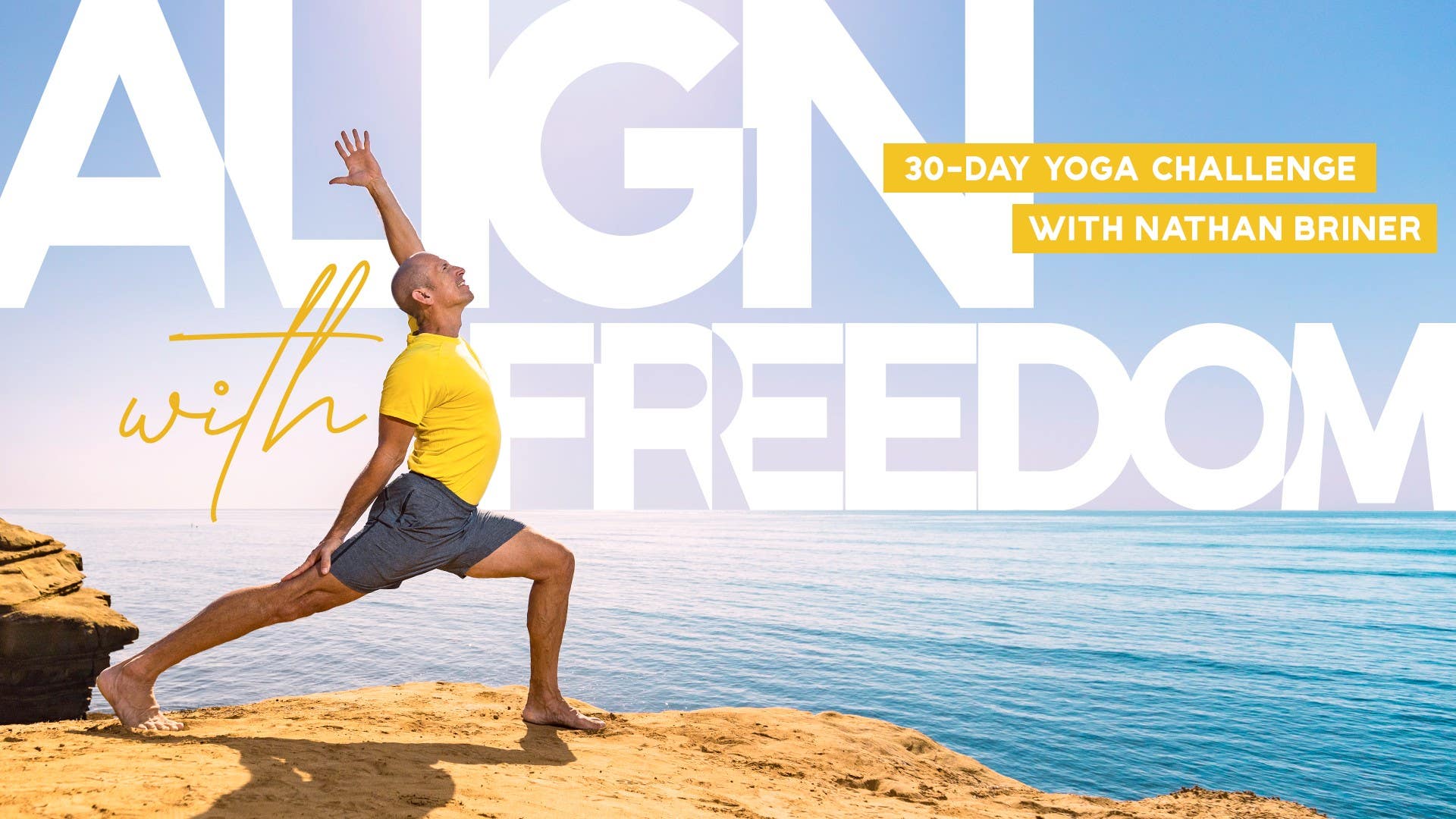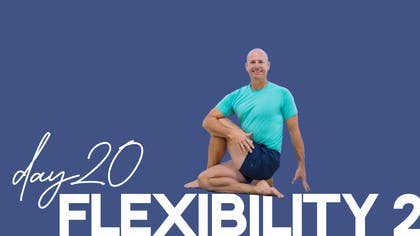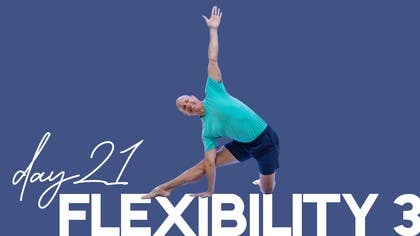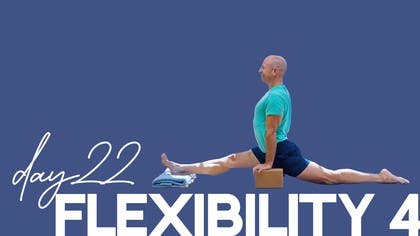Description
About This Video
Transcript
Read Full Transcript
Welcome back to day 20 of our 30-day challenge. This is our second day in the theme of flexibility and we're just coming back from a wonderful restorative session. We're going to be focusing today on the hips, building a few sequences to really open up the hips. We'll start on the back. We have a few props here today. A strap, block, and a blanket. We'll just start resting here. Take a few moments to check in. How's the body feeling today? Remember I love to hear from you so if you want to leave a comment let me know how you're doing, any questions you've got going on, anything we can work on together. Let's get a sense of how your breath is moving. And then let's start by crossing the left ankle over the right knee. We'll bring the right knee into the chest and with the two hands captured just behind the right knee joint. We'll try to keep the sacrum and tailbone fairly well connected to the ground and then drawing the left shin closer and closer to your chest. Take your time with this. Shoulders relaxed. Let there be space between your neck and the shoulders. Kind of try to keep some of that restorative energy that we had in our last session together. And we'll keep the legs more or less where they are. Arms out to the sides. Take a breath in and exhale as you roll the legs over to the right and down to the floor. And then if you like you can take your right hand against that left knee and gently push the knee a little bit away from you. But then we want the hips to do all that holding work so we'll let the arm back to the floor and the left hip will hold the knee pressed away. A few breaths here. We'll work into those outer hip muscles. And then a breath in. Exhale. Come on out.
Two feet on the ground about hip width apart. And we'll take the right ankle across the left knee. Bring the left knee into the chest and capture with the two hands right behind your knee. Sacrum and tailbone stay mostly against the ground. And then we're easing the left leg closer and closer to the chest. Shoulders broad. Soft neck. Soft face. And then we'll release the legs holding them in place going for a spinal twist in the other direction. Rolling the legs to the floor and that active push of the right knee away from the chest. This is a great everyday stretch for the hips. I can get a little bound up from sitting in chairs or even activities running. Things like that. Love this stretch to open up the hips. And then we'll relax the legs a little. Inhale and exhale your way back to center. Two feet on the ground.
Take a pause there. From here we'll grab the strap and we'll start with the right leg. Place the strap around the right foot, left leg down on the floor. Supta parangusthasana. Bring the leg up any amount that you can and still keep that right knee straight. So for some it may be down here. For others more 90 degrees or even beyond. We'll just start here activating the right quadricep and pressing the left leg firmly against the ground. Once again shoulder soft, neck soft. We can start adding just a little light pulse drawing the leg just a bit further into the chest or toward the chest. While we do this can you keep your left leg firmly down against the ground. That's kind of a telltale if you're pulling farther than your right hip will allow if that left leg wants to come up off the ground. And then we'll put the straps both in the left hand. Allow the right knee to bend and we're bringing down that right foot towards the left shoulder. Often I'll see in classes when I teach this pose the foot comes down toward the groin but we actually want to bring it up and over toward the right excuse me the left shoulder. It's kind of like a pigeon pose but in a relaxed position. And then release. We'll do the second side. Right leg down flat, bend the left knee, bring the left knee into the chest and we'll strap up that foot. Once again the left leg nice and straight activate the right quadricep. That's the left quadricep. Right leg down into the floor. Take some time here. Soft shoulders, soft neck. We start adding a little pulse into the left leg. Right leg stays firmly connected to the ground as we activate that pulsing. Both legs firm. And then let's pass the straps to the right hand. We're bending the left leg and bringing that left foot toward right shoulder. Holding here. And then release. We'll take the strap away. Put the strap off to the side. Let's roll up into cat and cow. On hands and knees take a breath in, exhale spine rounds up into the air, inhale spine goes down, exhale spine goes up mobilizing the hips, pelvis, spine all the way up to the top of the head. One more time. Inhale spine going down, exhale spine rounding up. Then let's move into a downward facing dog. Lift the knees. Take a moment to pedal out the legs. Open up the backs of the knees, the hips, nice strong arms, long spine. And then we'll stretch the heels down toward the floor and hold the dog pose. Soft head, soft neck. And then bring your feet together. Together feet downward dog. We'll start with the left leg today. Bring it way up into the air. High right heel. Let's hold here. From the palms of your hands to the tips of the toes of the left leg. Reach lengthen to your body. Then a big breath in, exhale. We'll bring that left foot forward to the hands, kneeling lunge. This might be a great time if you'd like to grab a couple of blocks to help with this next pose. We're gonna sit back slowly and you could put the blocks right here underneath your hands if you like. Otherwise we can sit back a little here and work on a little hamstring flexibility on the left side. Come back into your kneeling lunge. And again sitting back. Let the left toes come up off the mat. Into the kneeling lunge again. One more time. Sitting back, straightening that left leg to your capacity. And then releasing. Tuck the toes under. Let's step back. Dog pose. This is a great time to add a few thoughts about flexibility here. Let's bring the feet together. Right leg up. Left heel high. And depending on how your body is built, we might need to work toward flexibility. Bring the right leg forward.
Left knee down on the ground. Or we might need to use some muscular activity to prevent hypermobility. Let's sit back into the hamstring stretch. So for example if you're stiffer in the legs you might end in here and that's fine. But if you happen to be quite mobile you might have to put some muscular support behind that right hamstring so you don't hyperextend the knee. These are things we all have to discover within ourselves. Back into your lunge. And again pressing back. That really is the gift of yoga to be able to sense and understand how our body is. How we're built. One more time. Forward to the lunge. Pressing back. And we'll find our way into dog pose again. In dog pose you may notice that there's often a lot of energy at the knees. Sometimes hyperextending the legs. Got to be mindful of that. So we have some muscular support behind the knee joints. And then look forward. Walk to the front of your mat. We'll bring the feet together into a half uttanasana. Here's another great opportunity if you'd like to use blocks to support your pose right up here. I'll show with hands on the ground. We'll start one leg at a time. Bending a knee. And the second leg. Bending knee. And back and forth we're gonna go here. This is a great way to mobilize the hips in a forward fold.
Let's go a couple more times each side. And one more on each side. Into straight legs. We'll hold there for a moment. Bending the right knee. Right hand stays on the ground. Turn and open the chest. Left arm up into the sky. We get this nice lovely opening here to the left side hip. And then release. Two straight legs. Bending the left knee. This revolves the spine around to the right. We'll take advantage of that. Into a twist to the right. Release the hand down. Two straight legs. Long spine. Hands on hips. Inhale. Come all the way up. I'd like you to grab one of your blocks. And we're going to place the block into the tops of the thighs. High as we can. And walk the legs in fairly close to the block so you feel like you've got a good grip on the block. And we want to have a little bit of the block coming forward in front of the legs for this. Come into a half forward fold. First stop is to check that you have a nice long spine. We're gonna try to take any rounding out of the spine here. Place your hands right on the face of the block and slowly start to push the block back behind you. Check to make sure you've got nice strong support behind your knee joints. And the purpose of using the block like this is it teaches the thighs to roll in a little. Inward rotation of the legs and forward bending. They go together. Undo the pressure on the block for a moment. Redo the pressure on the block. Feel how that rotates the thighs a little. Allows the muscles of the hips to relax, to broaden. Undo the pressure. Redo the pressure on the block one more time. Feeling that rotation of the thighs. The hip muscles being taught to relax a little. And then come up. We'll release the block. Set it off to the side. And then we'll turn lengthwise on the mat for prasarita paratanasana. Wide leg forward fold. Take a nice big breath in. Lift your chest. Fold from the hips. Hands down to the floor. Like we've been working on, press into the floor to get that inner lift in the body. Legs nice and strong. If you feel you need blocks here to get your long spine, it's a great time to get those. And then bending the elbows. Walk the hands between the feet. And taking the head toward the floor. It may make it there, it may not. That's fine if there's some space. A couple nice long breaths.
Then lift the head again. I'm going to do a modified version of rotated triangle pose. We'll turn the left toes in and the right leg mostly out. Walk the hands over toward that right foot and the blocks if you're using them. Turn it open. In this version of rotated triangle pose, we can get into that flexibility of the right side hip without being fully into the pose. And then releasing down. We'll walk the legs over to the other side. Blocks and hands to the other side. Right hand on the ground. Left arm lifting. And then release the hand down. One more time to center. Feet squared ahead in the concave portion of the pose. That means we're trying to have a little concave in the back. To come up, place the hands on the hips. Use your strong hamstrings and hip muscles to lift. Heel toe the feet all the way together. And then a standing half-bound lotus pose. We'll start with the right leg coming up. Holding just underneath the front of the foot and allowing the leg to rest down. A little bit of a balanced pose. We're starting to get that motion in the hip. I'm just going to take this nice and easy. If you find that this is too much for the hip, you could take tree pose if you like. A little bit easier version of this still allows the openness of the hip. Lift the knee and release. Second side. We'll bring up the left leg. Holding underneath the foot. And a little bit of balance. We allow that knee to roll down toward the floor. Tailbone in. Take a few breaths here. And then lift the knee and release. Let's stand in mountain pose. Feel what's going on in the body. Reach down to the floor. Get that inner lift. And we'll turn toward the front end of the mat. Feet hip-width apart. Stretch the arms up into the air. Exhale forward full. Next pose is parangusthasana. Two first fingers and thumb wrap around the big toes. If that's a little too deep for you, hands on the block is fantastic. We'll start by lengthening the spine from strong powerful legs. Press the thighs back. That's this way. Back. But be mindful not to be hyperextending through the knees. Then big breath in. Exhale. Bend the elbows wide. Releasing the top of the head down. Thigh muscles are strong. Quadriceps active. And again, making sure that you're not overdoing the knee joint. You're not hyperextending there. Take a few more breaths here. And then hands to the floor. Bend the knees. Walk it back to a dog pose. Stretching the heels of the ground. Strong after farms. And then come down to the knees for a brief child's pose. And then pressing up into a seated position. Let's grab a block for the next pose. Barakonasana. We'll start here with the feet a little further extended than you might normally do. We'll bring in the block in just a second. We'll start with the feet together and almost like a diamond shape here. You can capture the feet and start to fold forward. Any amount that you feel comfortable in your body. In this pose, there's no need to drive the knees into the ground. Just let your legs and hips do what they do. We'll work a little deeper. And coming up, we'll take the block now like this. This widens out the hip joints just a little bit. Same idea.
You can wrap your hands around the toes and coming forward. This is a great way to build towards things like half lotus. Janusirshasana. Hips are soft, allowing for that forward mobility. How's your mind as you're working into this pose? Just noticing. Come up and one further possibility is to take the block now its widest and one more time. Coming into your pose. Noticing the hips. How are they feeling? Low back? Any adjustments needed? And then coming up. Let's set that block off to the side and we'll work on what's known as cradling the baby. We'll bring the left leg in first. Bring that leg up and wrap around the foot. If you can't wrap around, just holding here is fine. We'll try to put that foot in the elbow. Other hand holding the leg. I'm going to square the hips toward the front, toward the head of the mat and holding here. A few breaths. I mentioned again if you'd like you can put a support underneath your hips. That always helps to lift the spine and makes things just a little bit easier. And then release. Second leg. Bringing up the right leg. Once again we try to get that foot into the crook of the left elbow or you could just hold the foot perfectly fine. Grab hold and as we work into these deeper poses take your time. Take your time. As I'm fond of saying you know I've never seen golden light shoot out of anybody's eyes the minute they get their leg behind their head you know. Take your time with this. It's all about feeling what your body needs. This is the gift of yoga is to learn about you and then make any adjustments you need. Release your pose. We'll grab a block. Have a seat up on the block and we'll start by tucking the right leg underneath so the heel comes around the side of the block. And we can either put the left foot just to the inside of the knee or fully cross over. This is kind of a counter pose for the external rotation we've been doing so far. We'll start here by wrapping the arm right arm around left leg. Fingers of the left hand touching the floor. Nice and tall. Taking a few breaths and then release. Second side. Left foot pulled under so the heels just the outside of the block and choose what's right for you. Foot on the inside of the knee or you can cross the foot to the other side of the left leg. Once again we're holding and making that turn.
Take a few more breaths and then release. Unwind the legs. We'll put the block away and then lie down for a bridge pose. Resting here on your back for just a moment. Feet about hip width, knees hip width. Arms alongside you on the floor. Press your feet and lift your hips. Nice way to do this is to hold the side edges of your mat and really do hold on with all your fingers and thumb. Turn your arms outward biceps out to help you learn to roll the shoulders underneath and support your chest. Once you have that you can let your hands go from the mat. Palms face the ceiling. Take the tailbone deep inside in this pose toward the ceiling. Knees stay narrow hip width apart and it's a bit of a counter pose to our forward bends we've been doing. Press the shoulder bones down into the floor lifting the spine. And then ease your way back down. Release the shoulders. Let the back settle on the floor for just a minute if you'd like to do some easy sways of the legs left and right. It's a nice way to release any tension. We're working our way into Shavasana. When you feel like your back is nice and soft and relaxed we'll start to extend the legs out into the floor one by one. Turn the palms up toward the ceiling. Light tuck of the shoulders and then slowly closing the eyes. Draw your attention inside. Let the legs relax. Let them fall away from one another. And let the hands relax. Soft head, soft neck, soft face. And this is that practice of moving into stillness.
As we work on this theme of flexibility, going much deeper in our ability to feel our body, what we need, that really is what we're after here. You can learn when parts feel too stiff and to open them. When parts feel too mobile and to create strength around them. And that strength and mobility balance each other out. As we'll learn more in integration, that balance creates a quietness of the mind. And let your attention settle into the rise and fall of your breath as we move into stillness. And please stay as long as you need in your shavasana. If you're ready to come out, rest your hands on your tummy. One by one, bend your knees and turn onto your right side for a breath or two.
And use your hands and press yourself up into a comfortable seated position. It's great to be with you here on day two of flexibility. I'm looking forward to our next session where we'll dive a little bit deeper into some hip mobility, some new poses. Have a fantastic day and I'll see you next time. Namaste.
Align with Freedom: 30-Day Yoga Challenge
Comments
 I particularly appreciated comments on hyper-extending. In my decades of doing yoga, I have found little attention to how to work with this. Balance and strength - of course! Thanks, Nathan
I particularly appreciated comments on hyper-extending. In my decades of doing yoga, I have found little attention to how to work with this. Balance and strength - of course! Thanks, Nathan
You need to be a subscriber to post a comment.
Please Log In or Create an Account to start your free trial.



















